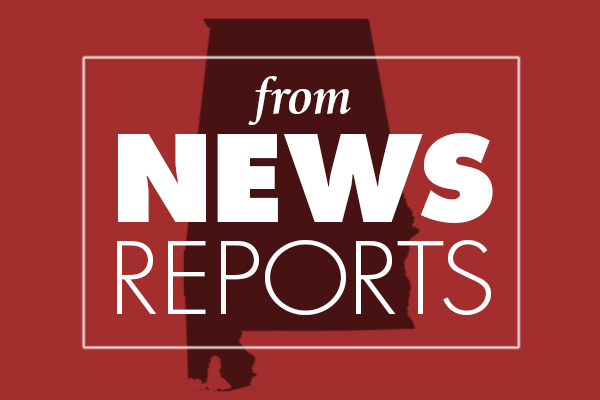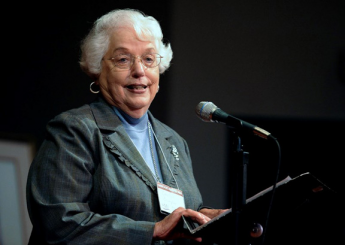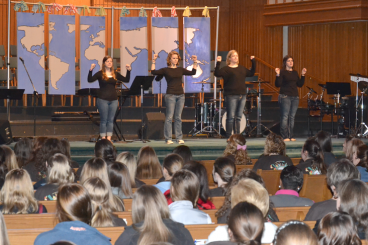A supercell storm kicked off a number of disturbances that spawned about 44 tornado warnings and six severe thunderstorm warnings in a 12-hour period May 7 as it marched across central Alabama.
“We had about 800 lightning strikes per minute and that was significant, a very big deal,” said Ken Lorek, a meteorologist with the National Weather Service, Birmingham. He estimates that 20–25 counties in Alabama were affected by the storm as it passed along the I-20 corridor from west to east.
The storms, with their torrential rains closed roadways, flooded automobiles and canceled Wednesday night services at many Baptist churches that were in its path. Wind, lightning, hail and floodwaters from the record-setting rains, which measured in double-digit inches in many places, caused isolated damage among Baptist churches.
The storm occurred on a day that was preceded by other storms and tornadoes across many of the same areas. Lightning from a May 6 storm in Heflin destroyed a Baptist pastor’s home.
About 9 p.m. May 6 lightning struck the home of Iron City Baptist Church Pastor Noel Dear after it hit a tree in his yard. Dear was watching the weather through a window in his house when the tree was struck.
“I saw the lightning strike a tree and it ran in through the pipes, then hit the water heater, severing the gas line and exploding and that’s what caught the house on fire,” he said.
All of his family, including his wife and their two daughters, ages 4 and 1, escaped without injury.
“I was thankful that my family was all safe. God took care of us as He always does, and I am thankful,” he said.
The disaster relief team of Birmingham Baptist Association (BBA) was activated immediately to help in metro areas of Birmingham affected by the storm, according to Tommy Puckett, who heads up disaster relief efforts for Alabama Baptists from the State Board of Missions.
“They set up their headquarters at Huffman Baptist Church in Birmingham and have a feeding kitchen there,” he said.
“They are still checking those areas that have been damaged to find out if there are cleanup efforts that will be needed,” Puckett said.
According to Mark Lawley, disaster relief coordinator for BBA, Huffman Baptist experienced flood waters from the May 7 storms. The church also opened as a Red Cross shelter.
“We had about two feet of water up against our welcome center entrance, and it came twice,” said Pat Ray, church administrator at Huffman. “It subsided and we thought we were OK, but then we had to start all over again.”
Ray said that from about 2 p.m. until about 3:30 p.m. the first waters came, then subsided. More water came and remained until about 5 p.m. Both floods affected the church fellowship hall, kitchen and offices. There was no flooding in the sanctuary since it is built on top of the fellowship hall.
BBA disaster relief remained on call the night of May 7 to help churches. By May 9, they were cooking on site for the Red Cross at the Huffman Church shelter.
He noted that they were preparing 1,500 total meals to be served on May 9 — some at lunch and some at dinner, and that the relief team would be serving two meals a day on subsequent days as needed.
Southern Baptist volunteers cook 80 percent of all meals served by the Red Cross nationwide.
According to Eileen Lewis, manager of programs and services with the Birmingham chapter of the American Red Cross, as of May 9, these Baptist churches in the greater Birmingham area were open as shelters: Bethel Baptist Church at Collegeville, Sharon Heights Baptist Church at Brookside, First Baptist Church, Pell City, First Baptist Church in Trussville and Huffman Baptist in Birmingham.
Lewis explained that some facilities volunteering space for Red Cross shelters are first-response sites. “We train members of churches so that when we need a shelter at their site it can pop up quickly — we call these self-sufficient sites. FBC Trussville is one of these. They were really instrumental in getting the initial phase of relief going,” Lewis said.
Communities just east of Birmingham also suffered damage from the storms.
According to Linda Cotton, secretary at Coosa River Baptist Association, lightning struck a transformer on a power pole next to Munford Baptist Church and destroyed three computers and a brand-new copy machine in the church. “The building has power and they are OK otherwise,” she said.
Sycamore Baptist Church, which is in the Sycamore community just north of Sylacauga, had damage to its steeple, but the steeple was not blown off of the church. They also lost a few roof shingles and winds blew down a tree in the churchyard, but it did not hit the church.
Lincoln Baptist Church, Lincoln, did not have damage from the storms, but because of the unusually heavy rains, they discovered roof leaks. Several church members reported trees blown down in their yards.
Calvary Baptist Church, Childersburg, sits in a flood-prone area, so volunteers placed sandbags against the fellowship hall doors to keep water out. They had no damage, but did cancel Wednesday night services, Cotton said.
Otis Bentley, director of missions for Randolph Baptist Association, said that he thought most of the tornadoes remained enough above ground level to lessen the damage.
“We supposedly had three tornadoes that came across our county on Wednesday, but none of our churches have reported any damage,” he said.
Nonetheless there was damage out in the communities of Wedowee. Bentley said that within the vicinity of the association’s office, a few trees were blown down and metal roofs were blown off of some buildings.




Share with others: